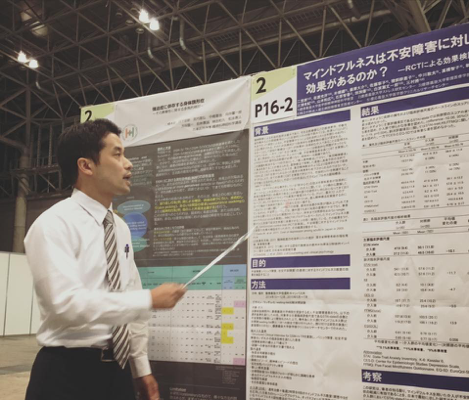不安障害に対するマインドフルネス認知療法の効果および費用対効果研究Effectiveness and cost-effectiveness studies of mindfulness cognitive therapy for anxiety disorder
諸外国では、マインドフルネスが不安障害に対して効果があることが確認されていますが、日本においても同様に効果があるかどうかはまだ十分に調べられていませんでした。そこで、我々は、不安障害の患者さんに対するマインドフルネスの効果を検証するために、最初に、対照群をおかない形でパイロット研究を行い、そのあとで、無作為化割付比較対照試験を実施し、マインドフルネスが不安障害に対して効果があることを実証しました。それぞれの研究の概要については以下をご参照ください。
We first tested the preliminary effects of mindfulness-based cognitive therapy on patients with anxiety disorders without a control group, and then, we conducted a randomized controlled trial. The study demonstrated that mindfulness was effective for anxiety disorders in Japan. See below for a summary of each study.
パイロット研究Pilot study
【目的】
この研究は、不安障害(パニック障害、社交不安障害、強迫性障害)に対するマインドフルネス教室の効果を、介入前後の比較で検証することを目的に行われました。
【方法】
パニック障害、社交不安障害、強迫性障害のいずれかの診断基準を満たす対象者13名に対して、毎週2時間全8回のマインドフルネス教室を実施し、実施前後で不安症状やうつ症状などがどのように変化するかの評価を行いました(対照群をおかない単群前後比較)。
【結果】
その結果、不安症状の尺度であるSTAI-stateの平均値は、介入前52.4だった値が、介入後は40.8(40点以下が正常域)と、ほぼ正常域まで、有意に低下することが明らかになりました(p値=0.001)。
結論:マインドフルネス教室が不安症状に対して、改善効果を持つことが示唆されました。だだし、この研究は、「対照群をおかない単群での研究」であるため、最終的な効果の検証のために、「無作為化比較対照試験」を、実施することとしました。
*本研究の成果を第111回日本精神神経学会学術総会(2015年6月大阪)で発表しました。
Pilot study
Objective: We compared the pre-post effects of mindfulness based cognitive therapy (MBCT) for anxiety disorders (panic disorder, social anxiety disorder, and obsessive-compulsive disorder)
Method: 13 subjects who met the diagnostic criteria for panic disorder, social anxiety disorder, or obsessive-compulsive disorder participated in MBCT (2 hours each week for 8 weeks). We assessed how anxiety and depression symptoms changed pre and post intervention (without a control group, single-group pre/post comparison).
Results: The mean value of the STAI-state, a measure of anxiety symptoms, was 52.4 before the intervention. After the intervention, there was a significant decrease to 40.8 (40 points or less is the normal range), almost to the normal range (p-value = 0.001).
Conclusion: The result indicates that MBCT could have an ameliorative effect on anxiety symptoms. However, because this was a “single-group study” with no control group, randomized, controlled trial is required to assess its definitive effectiveness.
The results of this study were presented at the 111th Annual Meeting of the Japanese Society of Psychiatry and Neurology (June 2015, Osaka, Japan).
無作為化比較対照試験Randomized Controlled Trial
【目的】
我々が前年度に実施した、パイロット研究の結果から、マインドフルネス教室が不安症状を有意に改善させる可能性が示さました。その結果を受け、無作為化比較対照試験で対照群と比較した場合のマインドフルネス教室の効果を検証する目的で、本研究が実施されました。
【方法】
パニック障害、社交不安障害のいずれかの診断基準を満たす対象者40名を介入群と対照(待機)群とに無作為に割り付け、介入群に対しては、通常治療に加えて毎週2時間全8回のマインドフルネス教室を、対照群に対しては通常治療のみを実施しました。また実施前後で両群に対して、不安症状やうつ症状などの評価を行いました。
【結果】
主要評価項目とした不安症状の評価尺度であるSTAI-stateの介入後(8週間後)の値は、介入群38.0、対照群 49.8であり(40点以下が正常域)、介入群は対照群に比べて有意な改善が認められました(p=0.002)。また特性不安の尺度であるSTAI-trait、マインドフルネスの尺度であるFFMQなどについても有意な改善を認めました。
【結論】
マインドフルネス教室がパニック障害、社交不安障害に対して、その不安症状の軽減に有効であることが示されました。また、STAI-traitの値も有意に改善したことから、マインドフルネス教室の効果が、長期的に維持される可能性も示唆されました。
*本研究の成果を第112回日本精神神経学会学術総会(2016年6月千葉)で発表し、筆頭演者の二宮朗医師が優秀発表賞を受賞しました。
また、英語論文がPsychiatry and Clinical Neurosciences誌にアクセプトされました。
Randomized Controlled Trial
Aim: The primary objective of this study was to examine the effectiveness of mindfulness-based cognitive therapy (MBCT) in secondary-care settings where the vast majority of the patients have already undergone pharmacotherapy but have not remitted.
Methods: Eligible participants were aged between 20 and 75 years and met the criteria for panic disorder/agoraphobia or social anxiety disorder specified in the DSM-IV. They were randomly assigned to either the MBCT group (n = 20) or the wait-list control group (n = 20). The primary outcome was the difference in mean change scores between pre- and post-intervention assessments on the State-Trait Anxiety Inventory (STAI). The outcome was analyzed using an intent-to-treat approach and a mixed-effect model repeated measurement.
Results: We observed significant differences in mean change scores for the STAI State Anxiety subscale (difference, -10.1; 95% confidence interval, -16.9 to -3.2; P < 0.005) and STAI Trait Anxiety subscale (difference, -11.7; 95% confidence interval, -17.0 to -6.4; P < 0.001) between the MBCT and control groups.
Conclusion: MBCT is effective in patients with anxiety disorders in secondary-care settings where the vast majority of patients are treatment-resistant to pharmacotherapy.
Keywords: anxiety disorders; cognitive behavioral therapy; mindfulness; randomized controlled trial; secondary care.
The paper was also accepted and published in Psychiatry and Clinical Neurosciences.

